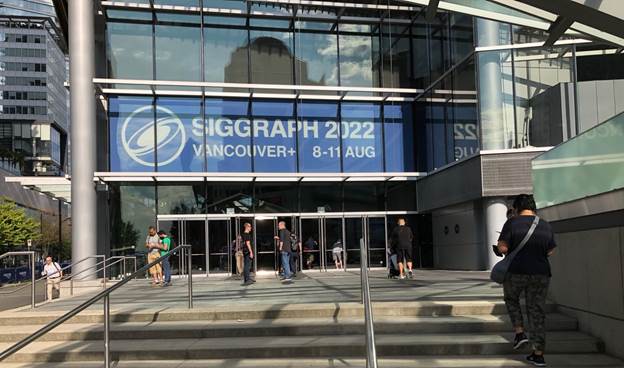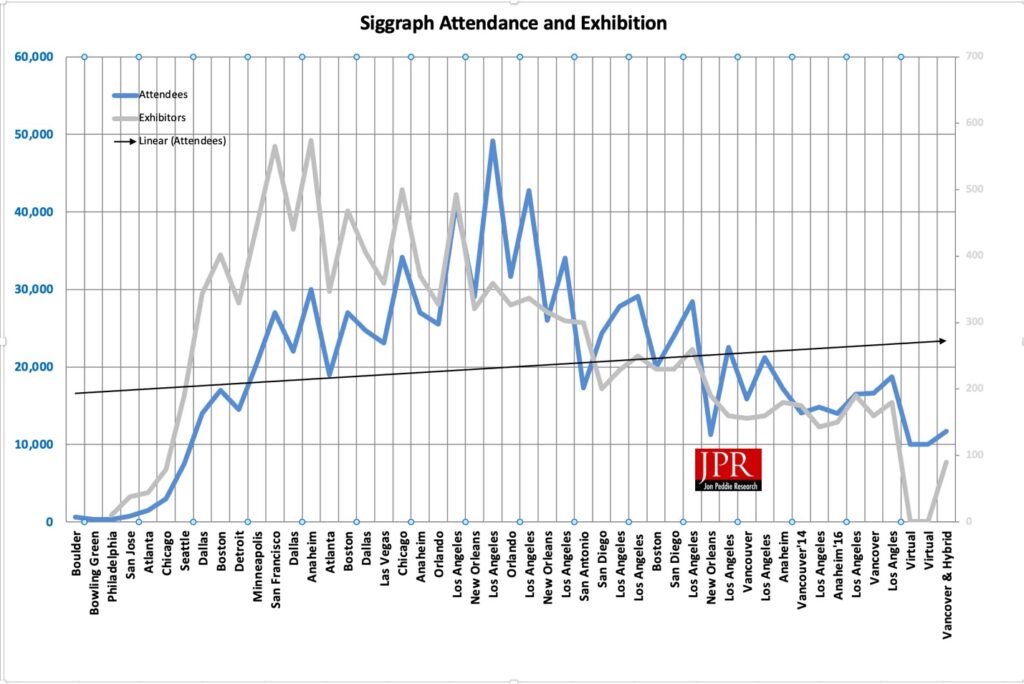The in-person portion of this year’s hybrid conference is now in the books, and it proved to be well attended.

At Siggraph, the annual conference and exhibition on computer graphics and interactive techniques, showgoers love to tell fellow attendees how many Siggraphs they have attended and which was their first. For me, it was Orlando, 1998. It was a bustling time, to say the least. It was a period of transition from proprietary to commercial, from expensive to more affordable. PCs were starting to replace SGI machines; Intel had just released the first Xeon Processor (Pentium II Xeon 400); AMD had introduced their new K6-2 line; and Alias’ Maya (now owned and developed by Autodesk) quickly became the talk of the show.
It was the year of no small feat as CG movies such as A Bug’s Life and Antz showed the power of computer animation, and Titanic—with its tidal wave of visual effects from Director James Cameron’s Digital Domain, including digital extras strolling the decks, CG set extensions, motion-captured passengers, and water/smoke VFX—sank the competition later that year to win Best Picture and Best Visual Effects at the Oscars.

Fast forward to 2022, and Siggraph looked a whole lot different, but the excitement was still ever present, as were the stellar Panels, Talks, Papers, and other long-standing elements, including the Electronic Theater, which make Siggraph, Siggraph. Gone, though, were the massive crowds, likely an artifact of years past. Despite being held outside of LA where numbers tended to surge, Siggraph 1998 boasted over 32,000 attendees and 327 exhibitors, many with two- and three-story booths. Nevertheless, this year’s conference had a healthy number of attendees (11,700), many of whom traveled to Canada for the Vancouver event. The show floor appeared condensed although with less sprawl than previous years, inhabited by 90-plus exhibitor booths and resulting in a populated area.
All in all, not a bad showing considering that the last in-person Siggraph, held in LA, boasted 18,700 attendees. However, that figure was the highest since 2013, signaling either a comeback or an anomaly.
OK, it’s worth mentioning the elephant in the room: Covid. I spoke with one of the conference’s longtime organizers, and it seems that quite a few people had held off registering for this year’s event until about two months prior. There were many likely reasons for this, and you can bet a good number of them involved Covid—the infection numbers, Canada’s strict entry policies, the attendee’s home country policies, and how comfortable people were around crowds in general. (To my surprise, I did not feel uncomfortable; perhaps it was due to the recent booster I received. And so far, so good….)
While having the conference in Vancouver generally presents additional hurdles, especially for US companies bringing equipment and personnel over the border, it does offer many more advantages. More than a few attendees and exhibitors had commented on the serene setting situated right next to the water and the convenience of walking outside for a quick moment of peace and quiet (that is, when a cruise ship is not alerting passengers of an impending departure, but those were few and far between). Inside, with the large windows offering breathtaking views, everyone seemed to be more relaxed, happier than they are in Los Angeles.
“After two years of meeting virtually [only], I was thrilled to host our return to a live, in-person conference in Vancouver,” said Munkhtsetseg Nandigjav, Siggraph 2022 Conference Chair. “Siggraph participants were incredibly joyful and excited to reunite and see the latest developments in our field. Being face-to-face at these Siggraph conferences is an annual recharge. It’s an opportunity to come together to learn, share our passions, and enrich our skills. I’m honored to be a part of this celebration as we continue to encourage the development and innovation in the arts and sciences that impact the world around us. And I’m looking forward to seeing how our work continues to evolve headfirst into the future.”
Let’s face it, Siggraph is a place where the industry comes together, to share ideas and just be around like-minded individuals. For the past two years, as the virus surged, Siggraph pivoted and did what they could by holding the conference virtually. It was a valiant effort, and they did get better at it the second year, and even better still the third. Yes, even for Siggraph 2022, there was a virtual component—the materials remain available through October 31, 2022, though registration is required. The virtual conference began a week prior to the in-person portion, and virtual attendees continue to visit the site.
Just to show how popular the virtual offering is, consider this: During the four days of the in-person conference, the multitude of elements available for virtual consideration drew more than 30,000 livestream views across the Talks, Courses, Production Sessions, Birds of a Feather, and Technical Papers.
Not long ago, there were murmurs that perhaps after so many years Siggraph had lost its audience. There was even informal discussion about returning the show “to its original roots” as an academic conference. However, the chairs and others who have worked so hard over the years to maintain a quality conference must be pleased with the turnout this year. Perhaps continuing Siggraph as a hybrid event is not a bad idea, as it provides many the access they would not have otherwise. Isn’t that what Siggraph is all about?
Next year is Siggraph’s 50th anniversary—quite a big deal. Details, however, are still scarce. Prior to Covid, we knew the locations and usually the dates at least two years ahead of time. In fact, the welcome booth at the current conference would even hand out pins related to the following year’s show and display signage concerning the locale and dates. That did not happen this year. We do know that the conference will be back in LA and that the chair is Erik Brunvand, but exactly when it will be held is anyone’s guess, though historically it occurs the first week of August, give or take a week. Likewise, no information has been provided as to whether there will be a virtual component. Of course, we have learned that unforeseen events can adversely affect even the best laid plans. But I would encourage Siggraph to consider a hybrid option (if in-person attendance is indeed possible) again next year and in the future to make the conference more accessible.





